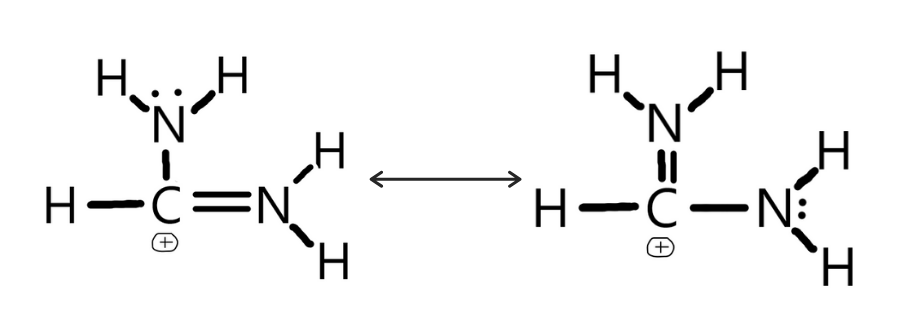The chemical name of CH(NH2)2+ is diaminomethyl carbonium ion which is a derivative ion of methylamine (CH3NH2) where two H atom of methane are substituted by two amine groups and further, the molecule loses an electron.
Lewis Dot Structure of CH(NH2)2+
Drawing of CH(NH2)2+ lewis structure (step-by-step)
1. Find out the total number of valence electrons
Here the ion is made up of three different atoms which are Carbon (C), Hydrogen (H), and Nitrogen (N) so first, we have to figure out the valence electrons of these atoms separately.
Valence electrons of carbon atom = 4
Valence electrons of hydrogen atom = 1
Valence electron of nitrogen atom = 5
Here in this molecule, we have one carbon atom, five hydrogen atoms, two nitrogen atoms, and one positive charge ion.
Total number of valence electrons: 4 + 1*5 +5*2 - 1 = 18
2. Determine the total number of valence electrons pairs
As we know the total number of valence electrons are equal to the addition of sigma bonds, pi bonds, and lone pair present at the valence shells. But it can be simply calculated by just dividing the total number of valence electrons by two.
For CH(NH2)2+, total valence electrons are 18 (as calculated in step 1), so total electrons pairs are 18/2= 9.
3. Find out the central atom
Finding the central atom while drawing a Lewis structure is the most tricky part but as described in how to draw a lewis structure guide, there is a simple trick for selecting the central atom which is obviously save of extra time and energy.
The carbon atom is in the least number so simply it will be the central atom and then nitrogen atom in the case of H and N atoms.
4. Drawing a simple skeleton
As we have already known the central atom so we can easily draw a simple structure placing carbon atom in central surrounded by nitrogen and hydrogen. The skeleton looks like this,
5. Put the lone pairs of electrons on atoms
It's time to put lone pair of electrons on atoms. For this, you have to make sure every atom except the central atom must have 8 electrons to follow the octet rule (hydrogen is an exception because it follows duplet rules).
Here we have to place one lone pair of electrons on both nitrogen atoms so that they have 8 electrons on each. No need to placed a lone pair of electrons on H atoms as all the hydrogen atoms have two electrons and hydrogen is happy with this.
We used all 18 valence electrons but still, central carbon has only 6 electrons now it's time to follow step 6.
6. Check the stability
For a lewis structure, all the atoms must be followed the octet rule means all atoms have 8 electrons. But here carbon atom has only 6 electrons so we have to stabilize the molecule by converting lone pair of electrons to bond pairs.
We can take any two electrons from any of the nitrogen atoms to form a bond pair between carbon and nitrogen. Again, check the stability, now all the atoms have 8 electrons so no need to take any extra pressure.
Also Read: NH2- Lewis Structure, Molecular Geometry, Hybridization & Polarity.
7. Identifying formal charge on the atom
The formal charge on each atom can be calculated as,
The formal charge (F.C) = Valence electrons (V) – Lone pair of electrons (L) – Bond pair of electrons (B)/2.
From this, we get a +1 positive charge on the central carbon atom.




Post a Comment